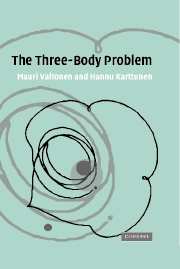Book contents
- Frontmatter
- Contents
- Preface
- 1 Astrophysics and the three-body problem
- 2 Newtonian mechanics
- 3 The two-body problem
- 4 Hamiltonian mechanics
- 5 The planar restricted circular three-body problem and other special cases
- 6 Three-body scattering
- 7 Escape in the general three-body problem
- 8 Scattering and capture in the general problem
- 9 Perturbations in hierarchical systems
- 10 Perturbations in strong three-body encounters
- 11 Some astrophysical problems
- References
- Author index
- Subject index
11 - Some astrophysical problems
Published online by Cambridge University Press: 04 December 2009
- Frontmatter
- Contents
- Preface
- 1 Astrophysics and the three-body problem
- 2 Newtonian mechanics
- 3 The two-body problem
- 4 Hamiltonian mechanics
- 5 The planar restricted circular three-body problem and other special cases
- 6 Three-body scattering
- 7 Escape in the general three-body problem
- 8 Scattering and capture in the general problem
- 9 Perturbations in hierarchical systems
- 10 Perturbations in strong three-body encounters
- 11 Some astrophysical problems
- References
- Author index
- Subject index
Summary
Binary black holes in centres of galaxies
Galactic nuclei are regions of high star densities as well as sites of very massive black holes, at least in many galaxies. For example, the central black hole in our own Galaxy is thought to be about 2 × 106M⊙ while the giant elliptical galaxy M87 possesses a dark central body of 3 × 109M⊙. The observed masses of these central objects are typically 1.2 × 10–3 times the mass of the spheroidal stellar component of their host galaxies (Merritt and Ferrarese 2001).
It is quite likely that there are also supermassive binary black holes in the centres of some galaxies, based both on theoretical (Saslaw et al. 1974, Begelman et al. 1980) and observational grounds (Komberg 1967, Sillanpää et al. 1988, Lehto and Valtonen 1996). They result most likely from mergers of galaxies. While the stars and gas of the two merged galaxies intermingle and form a new single galaxy, the central black holes remain separate for a long time, perhaps as long as the Hubble time (Milosavljevic and Merritt 2001). In the currently popular cold dark matter (CDM) model of cosmology it is believed that merging of galaxies is a common process (e.g. Frenk et al. 1988). Therefore binary black holes must also be common. How common they are depends on the interaction of the binary with the surrounding stars and gas clouds.
Information
- Type
- Chapter
- Information
- The Three-Body Problem , pp. 288 - 328Publisher: Cambridge University PressPrint publication year: 2006
